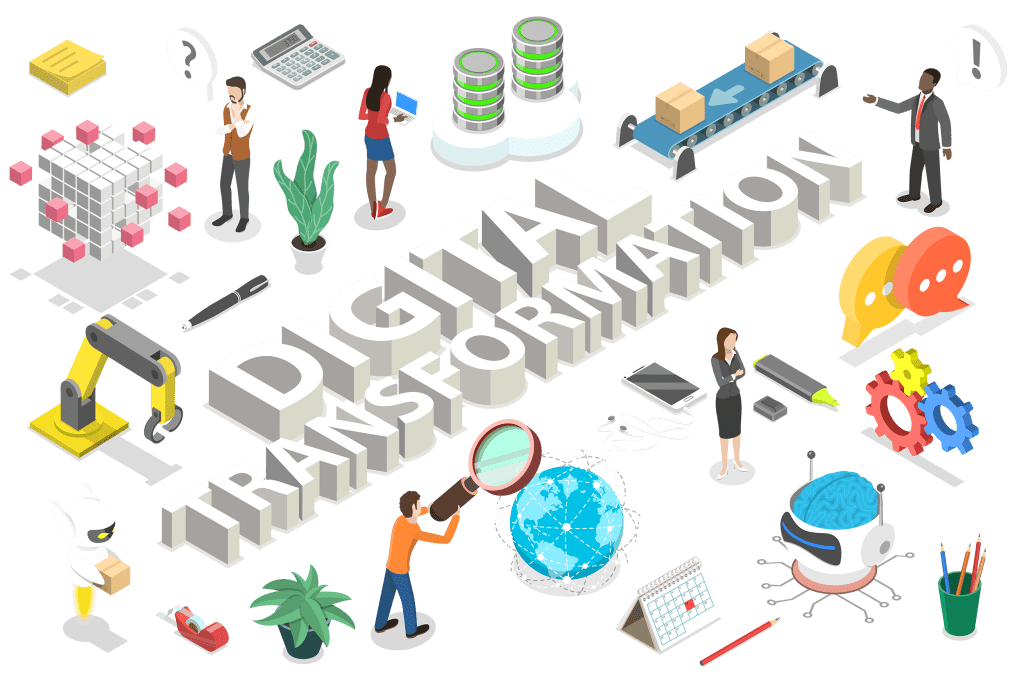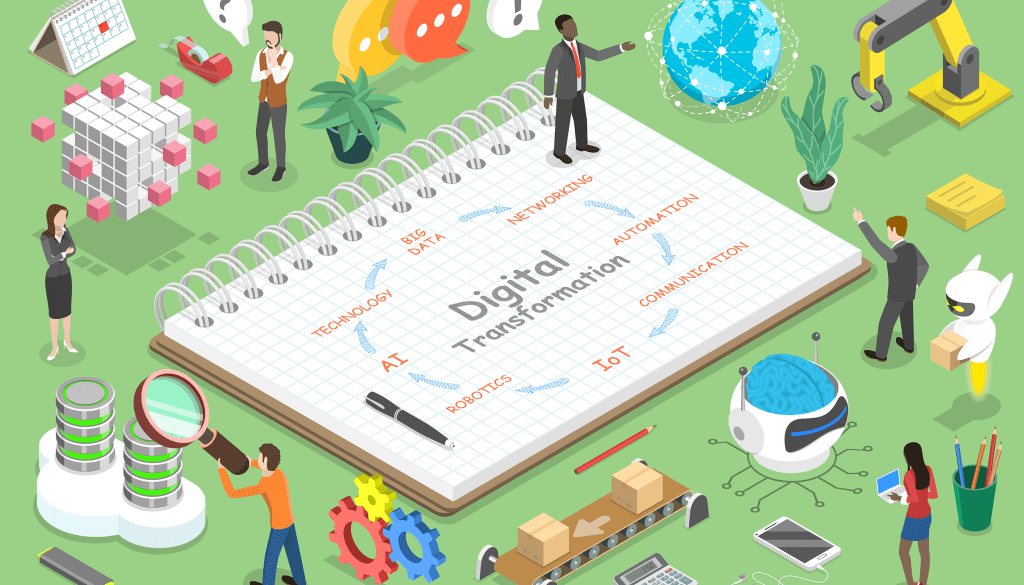4 Marketing Digital Transformation Trends for 2023
As we approach the end of 2022 and look towards 2023, it’s clear that the world of marketing is constantly evolving. Here are a few significant aspects of marketing that will be advancing in 2023.
Digital Transformation and its Importance in 2023
Digital transformation in marketing refers to the integration of digital technology into marketing processes and strategies to improve customer engagement and reach, gather and analyze customer data, and streamline marketing workflows.
It is important because it allows businesses to reach and engage with customers more effectively, gather and analyze data about their customers, and operate more efficiently and cost-effectively.
By using data and analytics, businesses can better understand their customers’ needs and preferences, and use this information to tailor their marketing efforts and create more personalized and relevant experiences for their customers.
Here are five best practices that companies will be using to implement digital transformation in 2023:
- Define a clear vision and strategy: Before embarking on a digital transformation initiative, it is important to have a clear vision of what you want to achieve and a strategy for how you will get there. This should involve identifying the key areas of your business that you want to transform and setting specific goals and objectives for each area.
- Engage key stakeholders: Successful digital transformation requires buy-in and support from key stakeholders, including leadership, employees, and customers. Engaging these stakeholders early in the process can help ensure that your digital transformation efforts are aligned with the needs and priorities of the business.
- Invest in the right technology: Choosing the right technology is critical to the success of a digital transformation initiative. It is important to carefully assess your needs and select technology that is both scalable and capable of meeting your business goals.
- Foster a culture of innovation: Digital transformation requires a culture of innovation and a willingness to embrace change. Encourage employees to think creatively and take risks, and create an environment that supports experimentation and continuous learning.
- Focus on continuous improvement: Digital transformation is an ongoing process, and it is important to continuously assess and adapt your efforts to ensure that they are meeting the needs of your business and your customers. Regularly review your progress, gather feedback, and make adjustments as needed to ensure that your digital transformation efforts are achieving their desired outcomes.
The need for digital transformation will be even more relevant in the following trends to watch for in 2023:
1. CMO and CTO Partnerships in 2023
In the modern business landscape, technology plays a crucial role in almost every aspect of operations. This is especially true for marketing, as digital channels and tools have become central to reaching and engaging customers. As a result, in 2023, we will see more chief marketing officers (CMOs) partnering with chief technology officers (CTOs) in order to effectively leverage technology to achieve their marketing goals.
One key reason for this is that CMOs and CTOs both have a role to play in driving innovation and adapting to new technologies. As the technology landscape continues to evolve at a rapid pace, CMOs will need to work closely with CTOs to stay up to date on the latest trends and determine how they can be leveraged to benefit the company. This may include implementing new marketing technologies, such as artificial intelligence or chatbots, or utilizing existing technologies in new and innovative ways.
Another reason CMOs and CTOs will need to partner in the future is that technology can be a key enabler for personalized and targeted marketing efforts. By working together, CMOs and CTOs can develop and implement technology solutions that allow for the collection and analysis of customer data, enabling more targeted and effective marketing efforts. This may include utilizing data analytics tools to better understand customer behavior and preferences, or implementing customer relationship management systems to track and manage customer interactions.
Finally, CMOs and CTOs will need to partner in order to ensure that marketing campaigns are delivered effectively and efficiently across a range of channels. This may involve working together to develop and implement marketing automation systems, as well as ensuring that marketing campaigns are properly integrated with other technology systems, such as CRMs or e-commerce platforms.
ICMOs and CTOs will partner in the future in order to effectively leverage technology to drive innovation, deliver personalized and targeted marketing efforts, and ensure that campaigns are delivered effectively and efficiently. By working together, CMOs and CTOs can help their organizations stay ahead of the curve and stay competitive in an increasingly digital business landscape.
2. Marketing and Artificial Intelligence in 2023
One major trend we expect to see in 2023 is the continued rise of artificial intelligence (AI) in marketing. AI has already been utilized in various ways, such as personalized recommendations and targeted advertising. In the coming year, we expect to see even more widespread adoption of AI in marketing, with companies using machine learning algorithms to analyze customer data and optimize their campaigns in real-time.
5 Ways AI will be used in Marketing
- Personalized recommendations: AI can analyze a customer’s previous purchases or browsing history and use that information to make personalized product or content recommendations. This can be done through email marketing campaigns or on e-commerce websites through features like “customers who viewed this item also viewed…”
- Targeted advertising: AI can be used to analyze a customer’s data and behavior to identify the most relevant and effective ads to show them. This can include ads for products or services that the customer is most likely to be interested in based on their previous interactions with a brand.
- Chatbots: Many businesses use chatbots on their websites or social media platforms to interact with customers in real-time. These chatbots are powered by AI and can answer common questions, provide customer support, and even make recommendations based on the customer’s needs.
- Sentiment analysis: AI can be used to analyze customer reviews, social media posts, and other forms of customer feedback to understand how customers feel about a brand or product. This can help businesses identify any issues or areas for improvement and adjust their marketing strategies accordingly.
- Content creation: AI can be used to generate unique content, such as articles or social media posts, based on a set of parameters or rules. This can be useful for businesses that need to produce a large volume of content on a regular basis but may not have the resources to do so manually.
Free Marketing Guide
Download the Definitive Guide for Marketing Managers
Over 60 pages of useful information you can use today, including 14 Knowledge Domains Marketing Managers should know, key terms that marketing managers use everyday and more.

3. The Rise of Digital Twins in 2023
A digital twin is a virtual representation of a physical object or system. It can be used to simulate and analyze the performance of the physical object or system in a virtual environment. Digital twins are created by combining data from sensors, simulations, and other sources to create a digital model of the physical object or system.
Digital twins are being used in marketing in a number of ways.
For example, companies can use digital twins to create virtual mockups of products to show to potential customers. This allows customers to see how the product would look in their own environment, and can help companies gather valuable feedback about the product before it is manufactured.
Digital twins can also be used to simulate and analyze the performance of marketing campaigns, allowing companies to optimize their marketing efforts and make more informed decisions about where to allocate resources.
Finally, digital twins can be used to create immersive virtual experiences for customers, such as virtual product demonstrations or virtual store visits, which can help companies engage with customers in new and innovative ways.

Examples of Companies Using Digital Twins in Marketing
There are a number of well-known companies that are using digital twins in marketing. Some examples include:
- Nike: Nike has used digital twins to create virtual mockups of its products, allowing customers to see how the products would look in their own environment.
- Coca-Cola: Coca-Cola has used digital twins to create immersive virtual experiences for customers, such as virtual store visits and product demonstrations.
- BMW: BMW has used digital twins to create virtual mockups of its cars, allowing customers to customize and view the cars in a virtual environment.
- Airbus: Airbus has used digital twins to simulate and analyze the performance of its aircraft, allowing the company to optimize the design and performance of its products.
- GE Appliances: GE Appliances has used digital twins to create virtual mockups of its products and to simulate and analyze the performance of its marketing campaigns.
These are just a few examples of the many companies that are using digital twins in marketing. As the technology continues to advance, it is likely that more and more companies will adopt digital twins as a tool for marketing and customer engagement.
Free Marketing Guide
Download the Definitive Guide for Marketing Managers
Over 60 pages of useful information you can use today, including 14 Knowledge Domains Marketing Managers should know, key terms that marketing managers use everyday and more.

.4. Fine Tuning Social Media Marketing in 2023
Social media marketing will also continue to be a key focus for businesses in 2023. With more and more consumers turning to social media platforms for information, companies will need to have a strong presence on these platforms in order to reach their target audience. In addition to traditional social media channels like Facebook and Instagram, we may see the rise of new platforms that offer unique opportunities for marketers.
In 2023 we will see more companies adopting social media channels to handle customer inquiries and complaints. Companies can use social media to listen to what their customers are saying about their brand and respond to inquiries and complaints in real-time. This helps to build trust and improve customer satisfaction.
Examples of Companies that Embrace Social Media to Handle Customer Complaints and Inquiries
There are many companies that use social media to respond to customer inquiries and complaints. Here are a few examples:
- Zappos: Zappos, an online shoe and clothing retailer, is known for their excellent customer service, including on social media. They have a dedicated team that monitors their social media accounts and responds to customer inquiries and complaints in a timely and helpful manner.
- Amazon: Amazon also has a dedicated team that monitors their social media accounts and responds to customer inquiries and complaints. In addition to responding to individual customers, they also use social media to provide updates and information about their products and services.
- Southwest Airlines: Southwest Airlines uses social media to not only respond to customer inquiries and complaints, but also to provide real-time updates about flights, delays, and other important information. They have a team that monitors their social media accounts around the clock to ensure that they can provide timely and accurate responses to customers.
- T-Mobile: T-Mobile, a wireless telecommunications company, uses social media to respond to customer inquiries and complaints, as well as to provide updates and information about their products and services. They have a dedicated team that monitors their social media accounts and responds to customers in a timely and helpful manner.
- Starbucks: Starbucks uses social media to respond to customer inquiries and complaints, as well as to share updates and information about their products and services. They have a dedicated team that monitors their social media accounts and responds to customers in a timely and helpful manner.
As we look back on 2022, it’s clear that the world of marketing has changed significantly in a short amount of time. The COVID-19 pandemic has had a major impact on the way businesses operate and market themselves, and it’s likely that many of these changes will continue to shape the marketing landscape in the coming year. Despite these challenges, we are confident that businesses will continue to find new and innovative ways to connect with their customers and drive growth in 2023.
Free Marketing Guide
Download the Definitive Guide for Marketing Managers
Over 60 pages of useful information you can use today, including 14 Knowledge Domains Marketing Managers should know, key terms that marketing managers use everyday and more.






